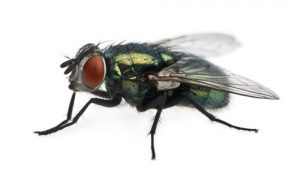Blow Flies Can Move Indoors
By Chris Williams on October 24, 2011.
Q. We have had an ongoing problem for years with those big, shiny green blow flies periodically showing up in our house, usually in the fall. I know they can be associated with dead animals but we haven’t had any of those that I know of. Where else can they be coming from?
A. You’re right. Blow flies (also called greenbottle or bluebottle flies) are most often associated with the carcasses of dead birds, rodents, or other animals. They are strong fliers and can find a dead animal within 20 minutes of its death. The dead animal is usually in places that are not obvious to us like chimneys, attics, crawl spaces, or wall and ceiling voids. Often, that dead animal is a rodent that was killed by toxic bait. The fly lays eggs on the carcass, the larvae feed on the decaying flesh, and the resulting adult flies that emerge often find their way into living spaces.
 Carcasses are not the only source of blow flies, though. They can also infest and feed on:
Carcasses are not the only source of blow flies, though. They can also infest and feed on:
Animal feces –Are there accumulations of pet droppings in your yard or in a neighbor’s yard?
Wet, rotting garbage –Do your outside garbage cans have lids and sealed bags? Garbage cans should be tightly covered and garbage should be picked up at least twice a week before blow flies have time to complete their development.
Decaying fruit or vegetables –If animal matter is not available for egg laying, blow flies can lay eggs in decaying vegetable matter. Are there rotting vegetables or fruits on the ground in your yard or in a compost pile? Grass clippings can even be a source of blow flies. Piles of wet, rotting grass clippings or other plants should be dried out or disposed of.
Since your blow fly problem indoors seems to be seasonal, occurring only in the fall, I think your blow flies are what we call “fall invaders.” Finding blow flies inside in fall and winter, does not necessarily mean that there is a dead animal. Blow flies often enter buildings during cool weather looking for warmth. You don’t say how many flies you typically see indoors, but a large number of blow flies usually indicates an animal carcass while smaller numbers may be an overwintering population.
Once indoors, the flies will find out-of-the-way places to hide and spend the winter, but they often become active again on warm, sunny days. They’re attracted to light and tend to buzz around windows.
You can probably get rid of your annual blow fly problem by doing a thorough pest-proofing of your home. This means finding and sealing all of the little openings and cracks and crevices that allow the flies to find their way inside in the fall. That can be quite a job but it’s one that we specialize in at Colonial. It may be too late this year, but early next fall you should have an outside perimeter treatment of your home to kill blow flies that are trying to find their way inside. We can schedule that for you, too.
Finally, you need to ask yourself why there are so many blow flies outside around your property. The answer could be as simple as the fact that you live next door to a pig farm! Or, are you breeding your own blow flies with accumulated pet feces or rotting vegetables? For instance, if you pile up all of your unharvested produce at the end of the growing season each year and let it rot, that could account for a seasonal increase in the numbers of blow flies around your property.